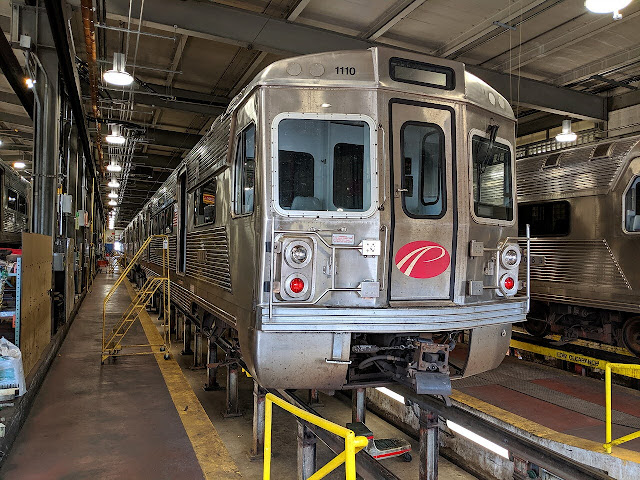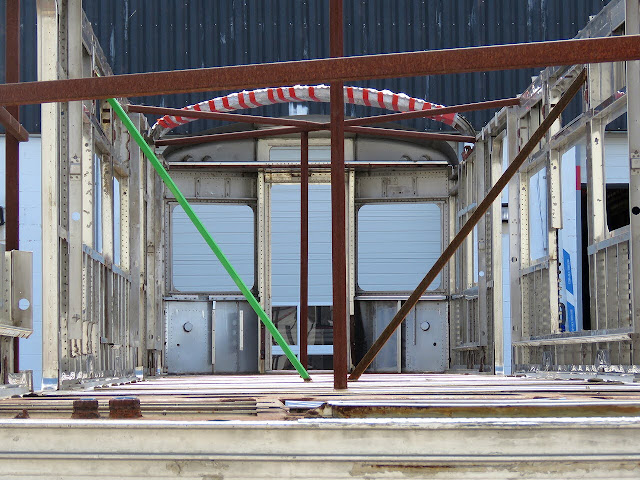The group met in the parking lot. It was a pretty good turnout, which is not surprising given the type of event.
First stop on the tour was the axle press that separates or joins various axle components including wheels, bearings and gearboxes.
Next stop was the machine shoppe area with the typical slate of drill presses, lathes and band saws.
PATCO's wheel truing machine is an older style that requires the trucks to removed and placed onto the machine with a crane. Newer wheel machines can work on trucks that are still under the vehicle. The machine grinds down worn wheels to restore the profile and remove flat spots.
Speaking of trucks, PATCO is one of two remaining users of the Pioneer III truck, the other being Amtrak with the Amfleet series. The P-III was designed by the Budd company as a lightweight truck that would derail less on bad track. It was available in both powered and unpowered variants and was previously installed on the SEPTA Silverliner II and MTA M1s.
The truck frames some in two halves and as you can see they are very simple affairs.
These gearboxes are connected to the truck and transmit power from the motors to the axles.
Here we see spare axle and gearbox assemblies ready to be connected to a truck.
PATCO uses GE 1255 A3 motors rated for 140 HP at 650/325 volts DC and 4600 RPM.
Two motors are mounted on each truck for a total of 560hp/car.
Finally the truck is mated to the car via this bolster, which I think uses an air bag suspension system and creates the soft bouncy ride.

The PATCO shoppe's high bay has one lift track for major repair work and a truck track where the trucks can be stored and assembled/disassembled. The lift tracks can life vehicles like in an automotive repair shoppe and although the original lifts have been replaced, I believe that PATCO was one of the first transit systems to make use of the concept. Pairs 1079-1080 and 1059-1060 were on the lift track.
Our tour guide doing his thing next to the truck turntable. Note the two overhead cranes that serve the high bay.
In addition to the high bay, PATCO also has two pit tracks for general inspection and minor repairs. Here we see former single unit #1110 on one of these tracks. There was a markedly different safety culture at PATCO compared to Baltimore including a light beam safety fence that would trip the 650v connection for live testing. Baltimore Metro had no such isolation system or even a problem with members of the tour group walking under cars on the car lift. The person giving the tour said it was expected for shop workers to get "stung" by the 650v DC at least once in their careers.
The inspection tracks had a mid-point crossover allowing for 4 married pairs to be inspected at any one two. This day the inspection tracks were half filled with 1066-1065 and 1109-1110.
With the PATCo car rebuilding effort, Alstom built a brand new inspection and checkout building across from the original shoppes. The three track facility features short third rail stubs as well as a section of high level platform and after the warranty period is up it will be used for additional inspection capacity as well as HVAC and other work that benefits from 650v power.
Sitting between the two buildings was the remains of PATCO single unit car #116. PATCO originally had an odd number of cars with 25 single units and 96 married pair units. The rebuild jointed the single units into pairs, which would normally result in an odd man out. This was ultimately a non-issue because car #116 suffered a fire in 1997 and was converted into a carbody parts doner that now sits between the two shoppes. Damage to the unreplaceable Budd stainless steel body shells can often be repaired with parts salvaged from #116.
The break/class room had been filled with diagnostic stations for all of the new equipment in the Alstom rebuilt cars.
After the tour had completed I lingered a bit in the parking lot to get these photos of the runaround track and its US&S ES-10 switch position indicators, as well as the Lindenwold substation.
I want to thank the West Jersey Chapter NRHS for organizing the tour as well as PATCO for hosting it. PATCO has a fairly high commitment to transparency and community engagement and they should be commended for it. Their operation is safe and efficient, which is pretty much all one can ask for. Next week check back for some additional Amtrak, MARC and DC Metro photos.

























No comments:
Post a Comment